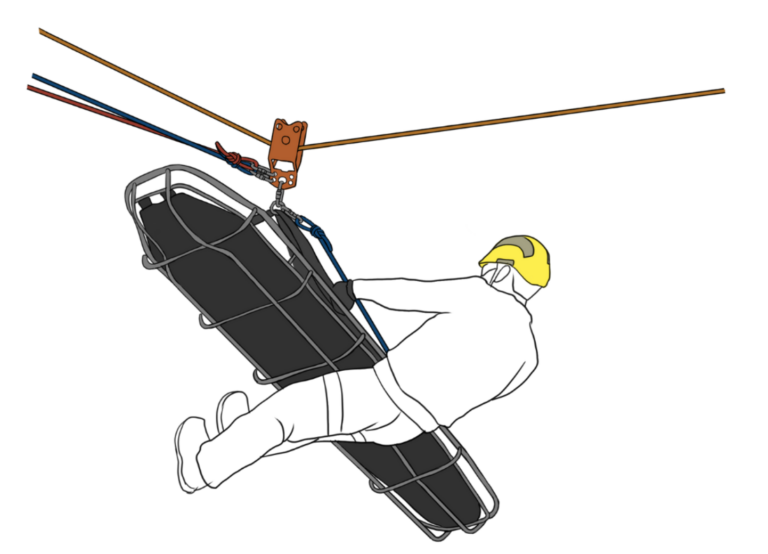Mastering Rope Rescue Operations: Key Areas of Expertise
Rope rescue operations demand mastery in critical areas to ensure both safety and efficiency. This guide explores five essential topics that form the core of advanced rope rescue knowledge:
- Mechanical Advantage Systems
- Knots and Knot Passing Techniques
- Anchor Systems and Bombproof Anchors
- Twin Tension Rope Systems
- Patient Packaging and Evacuation
By addressing targeted questions within these topics, you can enhance your understanding, refine your skills, and elevate your effectiveness in the field.
Mechanical Advantage Systems
Mechanical advantage systems use pulleys to reduce the effort required to lift or move a load. By multiplying input force, these systems make heavy lifting manageable. Key configurations include:
- Simple systems, such as the Z-Rig.
- Compound systems, combining multiple pulley setups for greater efficiency.
Questions
- What is the primary function of a mechanical advantage system in rescue operations?
- Name two types of mechanical advantage systems mentioned in this guide.
Learn more about these systems in our Mechanical Advantage Techniques.
Knots and Knot Passing Techniques
Knots are essential for secure connections and efficient load transfer in rope rescue. Techniques like the dog and tails method and twin tension knot passing ensure smooth operations, even with knots in the system. Understanding knot terminology enhances communication and execution.
Questions
- What is the dog and tails method used for in knot passing systems?
- Why is understanding knot terminology important for technical rescuers?
Explore additional knot resources in our Knots and Applications Library.
Anchor Systems and Bombproof Anchors
Anchors are the foundation of any rope rescue system. Bombproof anchors offer exceptional reliability and stability, crucial for ensuring the safety of the entire operation. Factors such as anchor strength and proper load distribution are key to creating secure anchor systems.
Questions
- Why are bombproof anchors critical for rope rescue?
- What is one key factor in creating a secure anchor mentioned in this guide?
For more insights, visit our guide on Anchor Systems and Bombproof Techniques.
Twin Tension Rope Systems (TTRS)
Twin tension rope systems involve two tensioned lines that share the load, providing redundancy and increased safety. Techniques like lowering through a knot using a Prusik hitch ensure a controlled and balanced descent.
Questions
- What is the main advantage of using a twin tension rope system?
- What is a common technique used to lower through a knot in a twin tension system?
Dive deeper into Twin Tension Rope Systems.
Patient Packaging and Evacuation
Patient packaging involves securing and protecting individuals during transport. Techniques such as using a litter and webbing immobilize the patient, ensuring their safety during evacuation. These methods often integrate with mechanical advantage systems to reduce physical effort.
Questions
- Why is patient packaging important in rope rescue?
- What is one technique for effective patient packaging mentioned in this guide?
Learn more about Patient Packaging Techniques.
Answers
Mechanical Advantage Systems
- To decrease the effort required to lift or move a load.
- Simple mechanical advantage system and compound mechanical advantage system.
Knots and Knot Passing Techniques
- It is used for efficiently managing and bypassing knots during rope rescue operations.
- It ensures clear communication and proper execution of rescue techniques.
Anchor Systems and Bombproof Anchors
- They provide secure and reliable points for attaching rescue systems.
- Ensuring the anchor point is strong and stable.
Twin Tension Rope Systems
- It provides redundancy and increased safety by having two tensioned lines.
- Using a Prusik hitch for controlled descent.
Patient Packaging and Evacuation
- It ensures the patient is secure and protected during transport.
- Using a litter and securing the patient with webbing.
Advancing Your Rope Rescue Skills
Mastering these critical topics strengthens your foundational knowledge and enhances safety and efficiency in the field. By reflecting on the questions and solutions presented here, you can refine your approach and elevate your performance in technical rescue operations.
For more resources and in-depth guides, visit the Rigging Lab Academy Blog.
Peace on your days,
Lance









